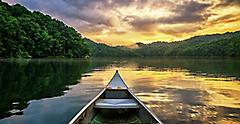You just need to pack and go.
For me, the main allure of setting sail on a short cruise is that in a few days, I can visit multiple destinations and experience them through food, culture, history, music and adventure, to name a few. On a short summer trip, I try to do it all and have found that these flash vacations can sometimes be even more immersive than a two or three-week trip. It's a matter of being organized, flexible and daring. The result: a myriad of epic experiences, a gallery of frame-worthy photos and a list of grand stories to last a lifetime. This was the vacation itinerary of my dreams, and all I had to do was show up with an open mind, ready for anything. You can do the same.
Going For Gold In Old San Juan
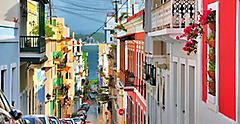
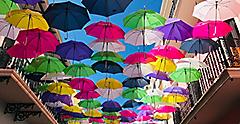
This time around, the surprise was a local jewelry shop called Coquí, named after the beloved local frog that faithfully carols every night. Here, I found several souvenirs: a flower pendant for my mom, silver sea turtle earrings for a friend and a delicate coquí bracelet made of 14-carat gold for, you guessed it, myself.
Then, I was on my mission to get to El Morro, the ancient Spanish fort, but I needed to make several stops before getting there. First, I made my mandatory visit to The Gallery Inn for a tour of the spooky grounds and a light and savory lunch in an open terrace surrounded by rustic busts made by the hotel's owner. The feeling is that of exploring a living 18th-century masterpiece, one that houses 15 patios and terraces, with secret nooks to sip on a glass of French wine or read a book from their library. You don't have to be a guest to explore the grounds, just visit the bar or restaurant for access to this very rare establishment.

I left the inn and headed to the Museo de las Américas for some much-needed cultural and historical immersion. I was mesmerized by an exhibit from local artist Antonio Martorell, Entretelas, featuring colorful paintings depicting the island and its people and celebrating the Puerto Rican spirit amidst the recent difficulties. The museum also holds permanent exhibitions about Puerto Rico's African ancestry and the indigenous Taíno's legacy. The building is three stories high, with a huge plaza in the middle, fit for kids to play while parents take a break from all the sightseeing.
Then, it was finally time to visit Castillo San Felipe del Morro, or El Morro, as we locals call it. This is where Spanish soldiers marched and fought to keep control of the capital against would-be invaders. This is also where families now gather to fly kites and enjoy the Puerto Rican sun. I headed straight to the big lighthouse inside the fort to imagine what it was like to guide the friendly vessels that came in and out of the once gold-rich port. I found out the spot was perfect for some meditation. I stayed there for almost an hour.
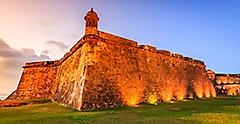
Fast Times In Charlotte Amalie

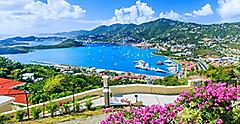

Once there, I came across Skydive to Paradise. I was able to ride up and down the tram as many times as I wanted for $25, which I did — six times to be exact. The tram whisked me 700 feet above the ground to witness sweeping views of the happy town and beyond. At the top of Flag Hill, a famous peak, I was greeted by a playground of food and drink with ridiculously beautiful views of the Caribbean. I grabbed a bite of coconut-crusted chicken tenders with an icy cold Bushwalker and declared that I would not come down the hill anytime soon.
My next adventure in St. Thomas had to be art or culture-related but also air-conditioned to cool down from the summer heat. I asked around for a recommendation for something rare and artistic to see. More than one local mentioned the Camille Pissarro Gallery, and I quickly went down the steps to find my way there. Camille Pissarro was one of the first French Impressionist painters, born in St. Thomas in 1830. The gallery used to be his home as a child, located on 14th Main Street. The beautiful paintings cover most walls and come in different sizes, big and small.
Two young girls were staring at one particular painting, a work called "Farmhouses and Palm Trees" from 1856. I stood next to them and listened to their interpretations of the work. "The guy on the horse is delivering mail to people," said one of them. "No, I think he's bringing plantains to fry them for dinner," said another. They were engaging with the painting, and I smiled at these kids exploring culture and learning something even on their summer break from school.
Then, I had a chance to enjoy "Farmhouses and Palm Trees" myself. It depicts a beautiful scene of tropical homes surrounded by thick palm fronds and people sauntering a dirt street while a man rides on a horse as if just arriving. The soft brushes and muted colors made for a dream-like world of tropical perfection. I too wondered what the man on the horse was carrying inside the saddlebags. Then, other paintings caught my eye, especially "A Creek" and "Two Women Chatting by the Sea." I bought a few small prints of these paintings to keep some of the impressionist magic with me, but I'll always think of plantains for dinner when I look at them.
Crucian Playtime

The next port of call was St. Croix, an island with a special kind of vibe. This is arguably the most beautiful of the Virgin Islands and certainly the most authentic. I arrived in storied Frederiksted town, one of my favorite towns in all of the Caribbean. Locals refer to it as "Freedom City" because this is the place where the emancipation of slaves took place in 1848 when the island was under Danish rule. Today, this beautiful slice of history sits by impossibly blue water and holds several attractions I love visiting again and again. Different tours are available, and it's an excellent place for kids to absorb some history and keep them interested.
One great place to start is the Caribbean Museum Center for The Arts, found inside a picturesque historic building. The open-air galleries showcase local art and that of neighboring islands. This time around, I was able to catch several great exhibitions, including "The Spirit, Artistry and Craft of Moko Jumbies" about the origins of stilt dancing and how the African art form reached St. Croix. I read that the dancers evolved from a spiritual context and represent "the powers of the creator fighting off all evil spirits." The moko jumbie is an icon in the Virgin Islands and a staple of island culture. Local artists presented their interpretations, and I was able to see their artistry's majestic expression. After this, I took a watercolor class in their lush courtyard. Others were taking batik, drawing and theater classes nearby. I felt part of a thriving art community and left knowing that I had really connected with the pulse and soul of St. Croix.
Next up was Christiansted town, where I hopped on a catamaran and sailed to what is perhaps one of the most stunning isles around, Buck Island National Park. If you're a snorkeling or scuba diving fanatic, or a nature enthusiast, this place will blow your mind with more than 180 native plants, all adorning the hilly landscape — and that's just what's on land. Under the water, the beauty continues.
History buffs will be interested to learn that the Kennedys visited Buck Island in the 1950s and fell in love with it. They were worried that the incomparable beauty could be damaged, and so they started legislation to protect the tiny island. Today, Buck Island is one of the few underwater national monuments in the United States, a place with preserved coral reefs and the home of many endangered species.
On my sail there, I was greeted by several giant sea turtles and a family of dolphins that swam alongside the boat for half of the trip, leaving us only when we got close to the island. Our tour guide said that it was common for the dolphins to swim with the boat, as if happy to meet us. As soon as we anchored, I jumped in the water and swam the rest of the way to shore, shocked at the distinct color of the beach: a rare blend of green and blue with a unique fluorescence. A quick look under the water revealed dozens of fish and sea turtles, all swimming without fear around me. I walked by the shore taking in the rare beauty of Buck Island, finding a sunny spot to sit down for lunch and a cold Leatherback beer. I enjoyed every bite and every sip with my toes deep in the white sand. I was not yet ready to leave the best summer vacation of my life.
Short summer vacations like this one are easy to have when you cruise. No other way offers the same number of destinations in a short time with zero hassles and headache-free planning. From Nassau, Bahamas, to Cozumel, Mexico, traveling in the summer lets you escape the day-to-day grind to paradise. It truly is easy living when you go cruising.
Get Royal Deals, Sign Up Today

Getting There
Explore Our Most Affordable Itineraries
Uncover the best places for traveling on a short trip as you plan a summer vacation cruise getaway onboard Icon of the Seas®.



